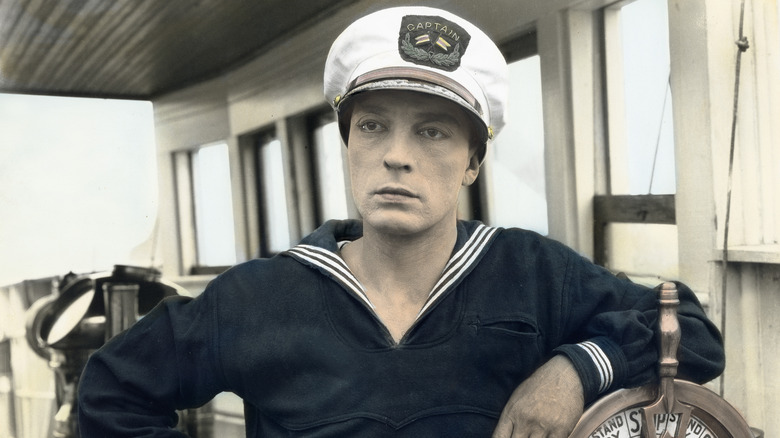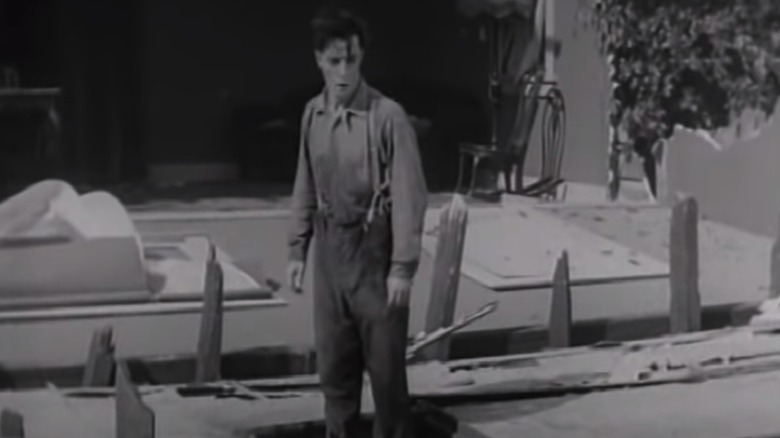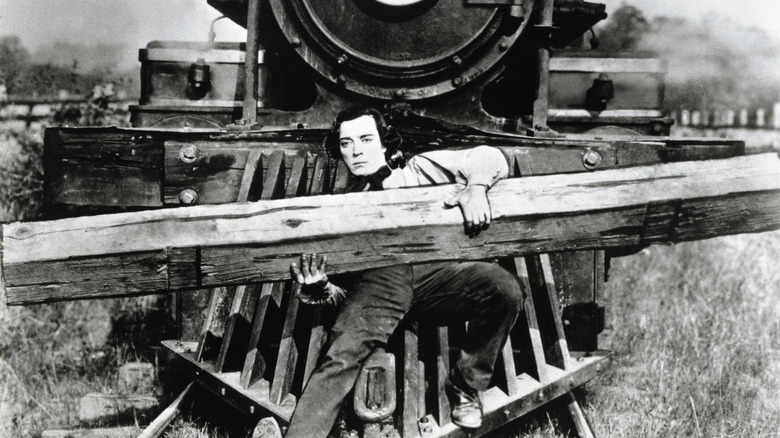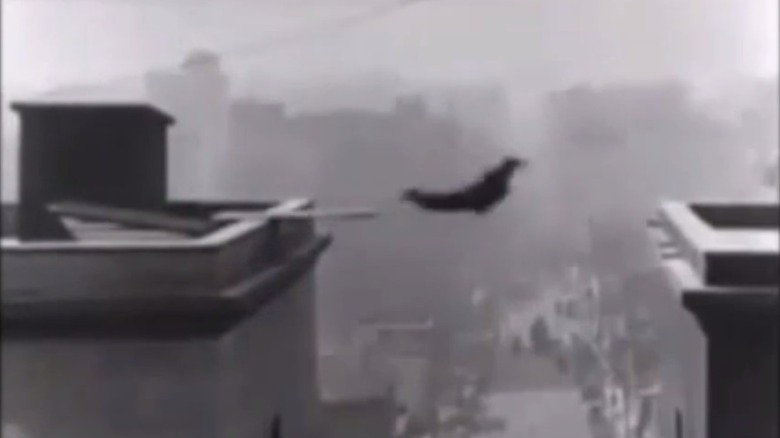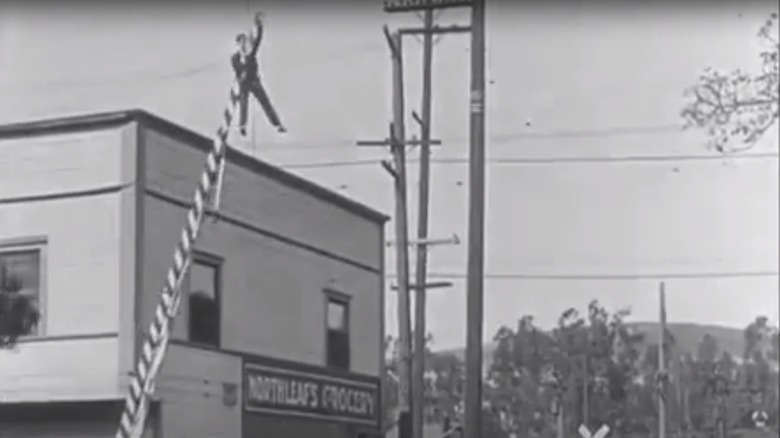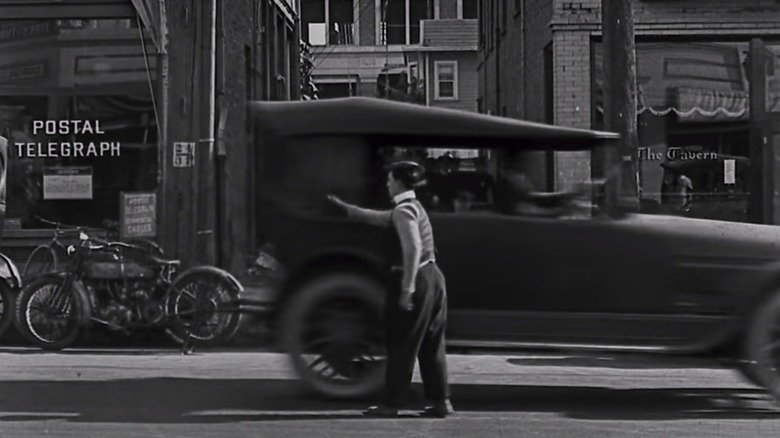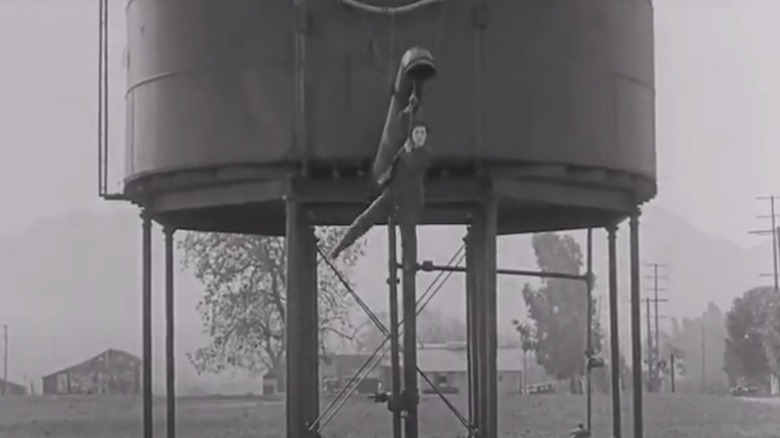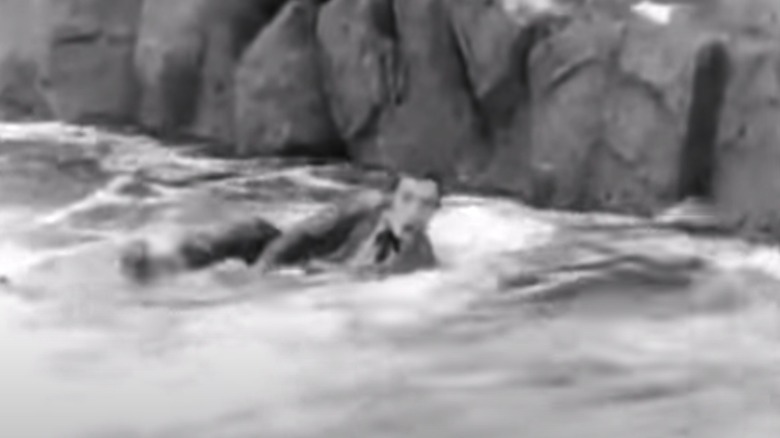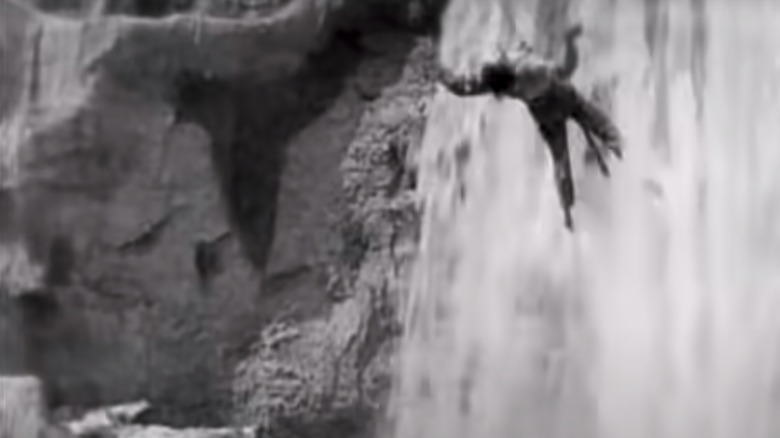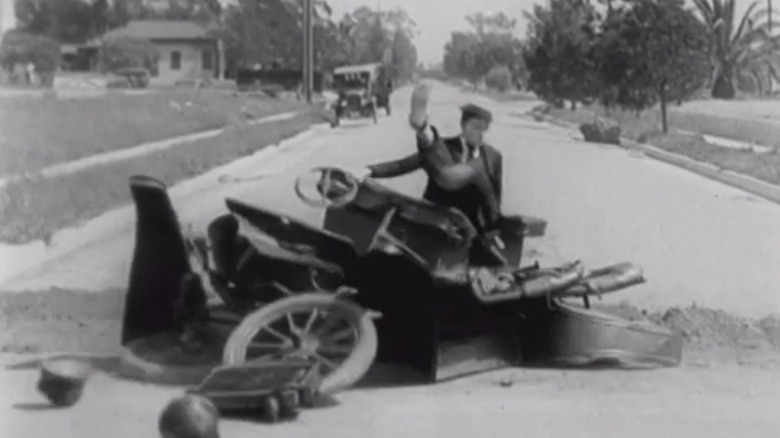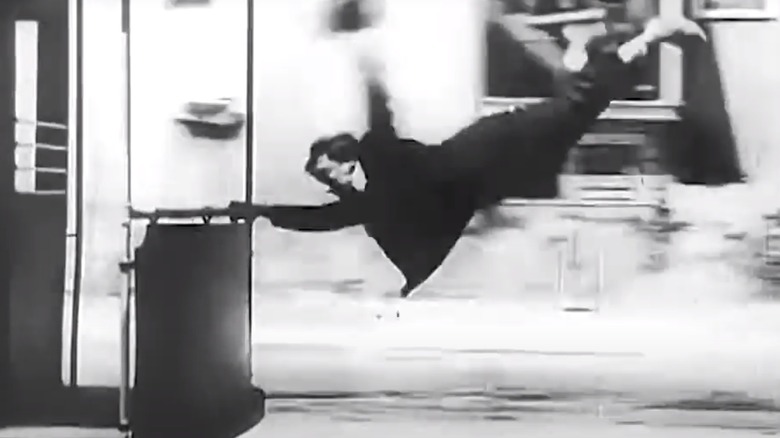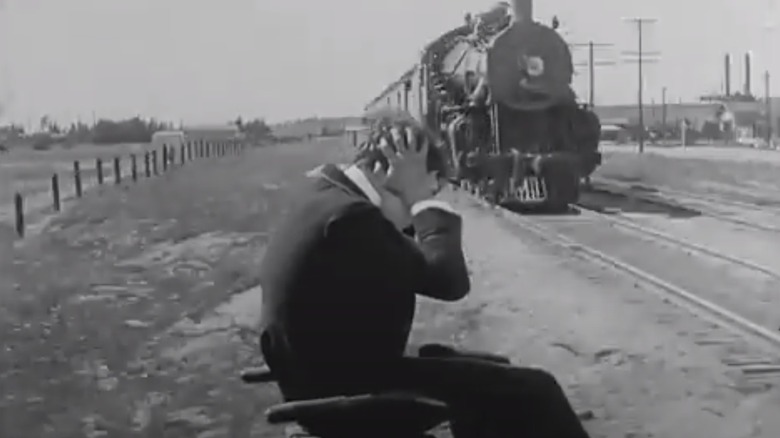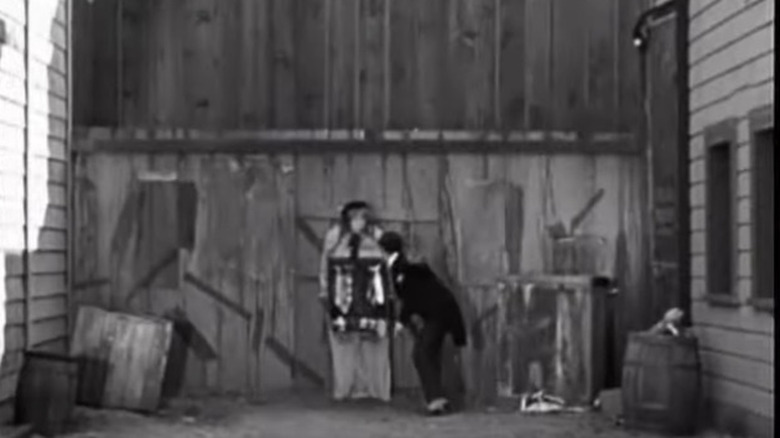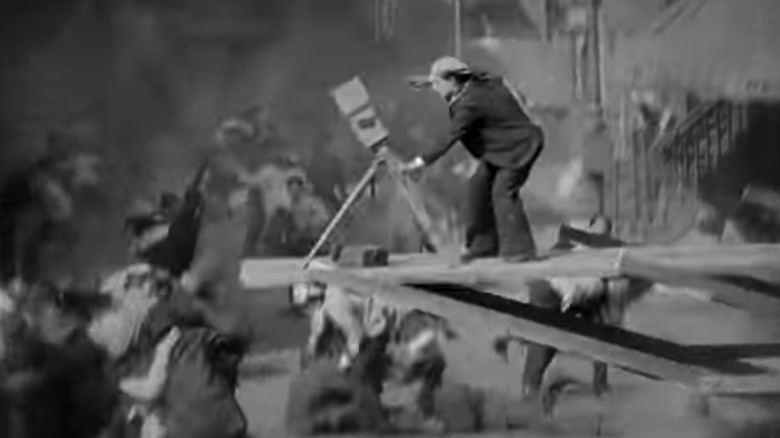Buster Keaton's Most Insane Stunts
Without Buster Keaton, filmmaker, comedian, and stunt man extraordinaire of the silent movie era and beyond, audiences may never have known the stunts of Jackie Chan, notes Mental Floss. Or have had the comedy of Bill Murray. Or the direction of Wes Anderson. Keaton, who was born in 1895 and was performing in his parents' Vaudeville act by age 5, would make dozens of movies and later appear in myriad TV programs during his lifetime. But his most influential work came during the 1920s, during which he created and starred in 10 silent feature films. In lieu of words, his extraordinary physicality made the movies work.
Sure, by the standards of today, many of Keaton's stunts look tame, but that's only until you realize the entirety of his oeuvre was completed without green screens, without stunt doubles, and with almost none of the safety gear actors today count on — he really was placing himself in harm's way in the name of his art. Frankly speaking, it's rather amazing Keaton died of cancer at age 70 in 1966, according to The International Buster Keaton Society, rather than during a film shoot when a young man.
Here are some of Keaton's wildest on-screen feats.
Buster Keaton had a house fall around him
In what was arguably Buster Keaton's most dangerous stunt ever, the entire façade of a house detaches from its frame and falls down around the actor after apparently being damaged during a hurricane in the film "Steamboat Bill, Jr." House of Geekery notes that, according to Hollywood legend, Keaton had to stand so still that he had his shoes nailed to the ground to keep him on his mark and complete the stunt. The Guardian called the stunt "As beautiful as it was potentially lethal," and indeed Keaton could have been killed instantly had things gone awry, as the falling house front weighed thousands of pounds.
Ironic that one of Keaton's most daring stunts involved no moving vehicles, tall buildings, or flying leaps, but instead some serious nerve needed to stand absolutely still. Reportedly, multiple crew members and even a camera operator turned away during the shot, convinced the star would be killed (via Mental Floss). As it happened, when the front of the house fell, Keaton was only within two inches of injury or death. The was one of several times where Keaton used a similar gag of a building collapsing around him, but it was by far the largest and heaviest such façade that ever nearly crushed the actor.
Buster Keaton could have died in two ways in The General
Known for never doing stunts the easy way or the cheap way, Buster Keaton would send an entire locomotive off of a bridge and crashing into a river in the climactic scene ending his Civil War epic, "The General." According to Ripley's, the stunt cost $42,000, a massive sum in 1926. Spectacle aside, the fiery train crash was not the film's most dangerous stunt, though.
That came in the form of Keaton riding on the front of a moving train while holding a massive rail tie across his lap. He used the rail tie he was holding to knock another off of the tracks, thereby preventing the train from being derailed. Keaton could have been injured or even killed had he failed to knock off the second tie off the tracks, or of course had he fallen from the train, especially if he ended up under the wheels of the massive locomotive. As the footage makes clear, he perfectly aimed the throw; his character's relief after doing so may be good acting, or may be genuine sentiment caught on film.
One of Buster Keaton's most famous stunts was a total accident
In one of the most famous scenes from the Buster Keaton film "The Three Ages," Keaton attempts to leap off a board from one building to the next but falls short, instead plummeting down through a series of awnings and then catching himself on a drain pipe that perilously pulls away from the wall. But all Keaton and the crew initially planned for was that first jump, according to History Daily.
Keaton ended up not jumping far enough and really did fall quite a ways down, fortunately into a waiting net. Thankfully, the actor's injuries only delayed production for a few days, and the stunt didn't potentially kill Keaton and cut short a career just kicking off. When Keaton saw the footage of his very real fall, he decided to work it into the movie, adding the awnings, the drain pipe, and the flying through a lower window as an afterthought to create a much more memorable sequence in the process.
Buster Keaton rode a falling traffic gate into a moving car
The 1924 Buster Keaton film, "Sherlock Jr.," included multiple stunts, including one in which Keaton casually rides a roadblock gate from the top of a building down into the back seat of a moving car, according to NSpirement. The stunt is not the most famous one from the movie, but it is a feat deserving of much more credit than it gets. Keaton had not only to use impressive strength and balance to cling to and ride the tall gate downward but also had to use perfect timing to ensure he landed in the car.
Had his timing been off, Keaton may well have been struck by the moving vehicle or landed behind the car, a much farther fall with greater potential for injury. As so often happened with Keaton's stunts, this one that would have been the crowning achievement for many films of the day was simply one part of a longer sequence.
Buster Keaton grabbed onto a moving car with one hand
In yet another stunt executed with such casual grace as to belie the immensity of the challenge and danger, not to mention the sheer strength required, in the 1922 short film "Cops," Buster Keaton evades a swarm of chasing police officers by hitching a ride with a passing car. But he does so by grabbing onto the moving vehicle with one hand and being pulled from the frame with his feet flying in the air behind him.
An analyst with a background in physics writing for Wired calculated that, based on Keaton's height and the size of the vehicle in the scene, the stunt was accomplished without camera tricks, like a change in the frame rate. Therefore what you see is what really happened: The actor grabbed onto the side of a moving car with one hand and zipped away down the street.
Buster Keaton breaks his neck in the infamous Water Tower stunt
As if running atop a moving train weren't wild enough, in "Sherlock Jr.," Buster Keaton got off of said train by grabbing onto the spout of a water tower he was passing, releasing a torrent of water that sent him hurtling to the ground. And all of that was exactly as the stunt was supposed to happen according to the plan.
While filming the stunt, however, Keaton was blasted downward with much more intensity than expected by the sudden water pressure, smashing his neck on one of the rails below. According to The Vintage News, the fall actually ended up in a broken vertebra in Keaton's neck, something you would not guess when you see the actor clamber back up to his feet in the very same footage. Despite severe headaches in the days that followed, Keaton kept on working on the film without taking a break. The fact that he had broken his neck would not come out until revealed by an X-ray many years later.
Buster Keaton was almost swept downstream to his death
Despite his willingness to risk life and limb in the name of a great stunt, Buster Keaton did not actually have a death wish. Thus, when plausible, he did employ safety gear, and that was the case in a scene in "Our Hospitality," where Keaton braves a rushing river. The already dangerous stunt became an actual life or death situation, however, when the submerged safety line used to keep Keaton from being swept away down the raging Truckee River snapped, sending the actor down through the rapids.
Keaton managed to cling to a branch as he rushed past it, having already endured bruising injuries caused by impacts with rocks. The filming went on, and as so often happened in Keaton's films, the shot with the unexpected twist remained in the final cut of the movie, according to Silent Film. The viewer watching closely can see the moment the cable snaps: Keaton turns about to look at the camera, his eyes wide in genuine terror. As the story goes, while pulling himself out of the river, he was surrounded by dozens of water snakes. They caused him no further injury, fortunately, but unfortunately the serpents were not caught on film.
Buster Keaton needed medical attention after waterfall rescue
In another harrowing scene from "Our Hospitality," Buster Keaton was suspended from a rope swinging out into the rush of a waterfall as he tried to save a woman from falling over the edge. The waterfall was a manmade construction on a set that was built over a studio swimming pool, not a natural feature of a location, and the woman in question was a mannequin in the actual rescue scene, notes Roger Ebert. But the water volume was real enough, and it was more than enough to overwhelm the actor. Knocked about by the rush of water, Keaton ended up accidentally consuming a dangerous amount of liquid.
According to Silent Film, Keaton said of the incident, "I had to go down to the doctor right there and then. They pumped out my ears and nostrils and drained me, because when a full volume of water like that comes down and hits you and you're upside down — then you really get it." Of course production was not delayed by the harrowing experience.
Buster Keaton casually rides in a collapsing car
Buster Keaton displayed not only his willingness to put himself at physical risk but also his comedic timing in a scene in "Three Ages" wherein a "very fragile car" literally falls apart around the actor (via Rotten Tomatoes). In the scene, a surprised Keaton has a convertible in which he is riding fall to pieces all around him, including all four wheels detaching, the axles splitting, and the sides of the vehicle coming apart.
He pops up next to the pile that used to be a car, still holding the steering wheel, which he then comically hurls to the ground. The falling apart car gag would be used in other films of the era, but no other actor arguably pulled it off as well as The Great Stone Face, the nickname Keaton earned for his famed deadpan acting even in remarkable scenes, according to The New York Times. "Three Ages" was Keaton's first feature as both star and director (and writer, in fact) and is not considered his best work, but it very much established the young filmmaker when released in the fall of 1923.
Buster Keaton flies along behind a racing streetcar
According to SF In Film, "In 1922 Buster Keaton filmed what was probably the first chase scene to use San Francisco locations." In the scene, a part of the short film "Daydream," Buster Keaton runs after a speeding trolley and then grabs onto the back of the streetcar. As it continues to accelerate, he veritably flies behind the vehicle, legs parallel to the ground as he is pulled along. Keaton then pulls himself aboard the trolley with his standard effortlessness.
But consider this — had he lost his grip during the scene, Keaton would have been flung down onto the roadway at high speed, almost surely suffering severe injury. All the more impressive is the fact that, initially, Keaton holds onto the moving trolley car with just one hand. In a scene that closely follows after his amazing boarding of the trolley, Keaton is thrown off for lacking proper payment, rolling off the moving streetcar onto the roadway — again it is a stunt that is taken for granted given the wild physicality of the preceding display.
Buster Keaton used camera tricks in the Sherlock Jr. chase
While Buster Keaton is best known for doing all of his own stunts without the use of trick photography, he was not opposed to using camera tricks and editing when doing so would yield to the best scenes for the film. Thus, according to Insider, Keaton employed some then revolutionary camera tricks in the filming of the 1924 film, "Sherlock Jr." He and his crew filmed several scenes from the movie's famous car (and motorcycle) chase in reverse, thus creating a hair-raising, intense chase scene without putting the star in any real danger.
In the most dramatic clip from the chase, Keaton looks to cut right in front of a speeding train, narrowly dodging death. In fact, the train and Keaton were both moving backward, and there was no risk to anyone involved in the production. This sequence, which mesmerized at the time and is still impressive, could be considered one of the first great chase scenes of American cinema.
The confounding trick Buster Keaton used to jump through a suitcase
Kinema describes a scene in "Sherlock Jr." in which Buster Keaton, chased by thugs, "finds himself trapped by a wooden wall between two houses. ... We then see a man in a dress holding an opened suitcase of ties back up to the wooden wall; in a medium shot, he points at his open suitcase to Keaton. When the two thugs appear on scene, Keaton jumps through the man's suitcase and body, disappearing completely as the man in a dress steps forward to reveal nothing behind him."
While hardly a death-defying stunt, the scene mystified audiences and was not fully understood for many years. It was later revealed that this disappearing act involved the person with the suitcase lying prone on a hidden, elevated platform and a trap door in the wall behind him. As soon as Keaton passed "through" the suitcase, the other actor dropped down onto his feet, and the hidden hole in the wall was closed, notes Classic Movie Hub.
Buster Keaton rode a crashing stage to the ground in The Cameraman
In one of but many physical stunts in the 1928 film "The Cameraman," Buster Keaton rides a collapsing scaffold to the ground, his character never once stopping the action of cranking the camera until the structure breaks apart around him, and he is thrown to the ground himself. According to Cineaste, the film was directed by Edward Sedgwick, though it's widely accepted that Keaton co-directed, and he clearly had a hand in planning the comedic stunts — the film coming at the apex of his silent movie career (and near the end of that era, in fact).
During the collapsing stage stunt, Keaton perfectly maintains his stoic, deadpan composure — the very type of delivery for which he earned the nickname Old Stone Face in the first place. Also in keeping with his usual operating procedure, the stunt was a one-shot deal, filmed in real time without multiple takes or rehearsals (via Open Culture). This was very much the way so many of Keaton's stunts were pulled off, largely because in many cases the set or prop being used in the scene was completely destroyed in the execution of the stunt, as happened with everything from cars to building façades to an entire train.
